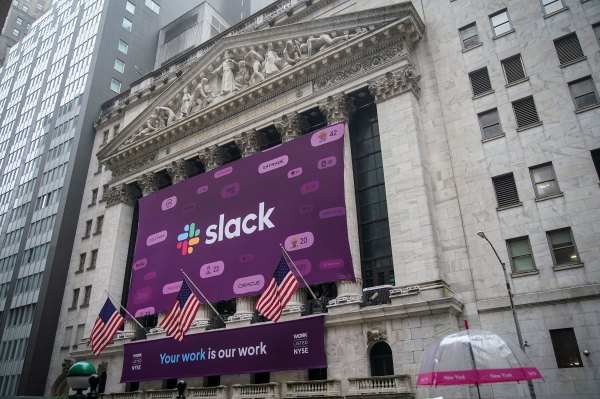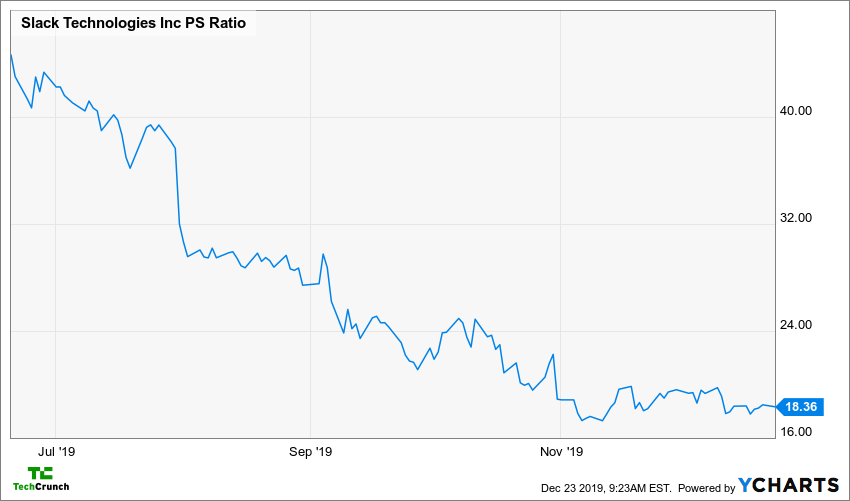One odd thing in 2019 has been Slack’s falling share price contrasted against the rising value of the Nasdaq composite, a tech-heavy index that many use as shorthand for the US tech market. Why one of tech’s hottest, and fastest-growing companies was losing altitude while tech stocks themselves broadly rose has been interesting to unpack.
Whether it was software-as-a-service’s (SaaS) modest repricing from summer highs, Microsoft’s Teams push, or Slack’s initial value just being too high, what the workplace productivity company is really worth has been an open question since it began to trade earlier this year; what became plain as the year went along, however, was that its initial trading range (above $40) and direct listing reference price ($26) were far too high, and a little too high, respectively.
But as the year comes to a close Slack has found a trading range that it likes, as we touched on a few weeks ago. This has led to the company’s revenue multiple itself stabilizing, which we should take a moment to explore. Why? Because the company’s new price/sales stability helps set a useful, upper-bound for SaaS valuations to an important degree. And because Slack’s new valuation is at once a real achievement, and, at the same time, a modest disappointment.
It’s a good metaphor for the current value of unicorns despite earlier, higher, expectations.
Multiples
Considering Slack from a revenue multiple perspective is a way to understand how much investors are willing to pay for Slack’s top line income. The higher Slack’s revenue multiple, the more bullish investors are concerning its future prospects; the lower Slack’s revenue multiple the more pessimistic investors are about the company.
Slack has never had a pessimistic revenue multiple, so far as we can tell by observing the data. Recalling some previous work, Slack’s final revenue multiple as a private company was rich:
-
Slack Q3 2018 implied ARR multiple: 16.9x
In an year of roughly 10-11x SaaS revenue multiples (data from Bessemer here), Slack’s historical results stand out sharply.
Slack’s public revenue multiples got even more wild. Here’s YCharts:
Reading the upper left bit of this chart, we can see that public investors initially valued Slack far more richly than its preceding, private investors who had pumped huge sums into the SaaS giant. In retrospect, what did they expect would happen?
But turn your gaze to the lower, right side of the chart. Starting in about November, Slack levels out at around 18x1 its revenue. What’s fun is that that figure is between is just a smidge above its final private ARR multiple (which compressed after the investment, when the company’s value stayed flat as it grew towards its direct listing, of course.)
So, public investors are a bit more bullish on Slack than its final private investors. That’s neat to know, and useful.
For yet-private SaaS companies, Slack is a useful ceiling. If your company is as good, you can expect this sort of multiple. But, as nearly every SaaS company is less than Slack in some way — net retention, ARR growth, whatever — we can treat Slack as a near high-water mark. Companies like CrowdStrike have a higher multiple today, but not by much, and there aren’t very many companies that are valued more richly.
Tying this narrative up after about a half-year’s tracking, Slack is worth a lot, even if it is a bit less than its initial public market hype might have had us believe. This is something that also holds true for Dropbox and Pinterest, two hugely-valuable technology companies that saw their shares soar in their first weeks as public companies, before quickly giving back ground. Only neither of those companies are worth anything close to what Slack is on a multiples basis. Pinterest is worth about half that, and Dropbox about a fourth.
That makes Slack the winner of the group, I reckon. And as nearly any company would kill to trade at 18x revenues, it’s a winner, full stop. (Though trading at 25x as it was earlier in the year, I’m sure would be welcome.)
- Slack’s current ARR multiple, using its FQ3’20 results is about 17.5x today, so the numbers are close enough for our taste; please don’t write in whining about us using a revenue figure for a SaaS company, we already know your complaint and don’t need to hear it.

